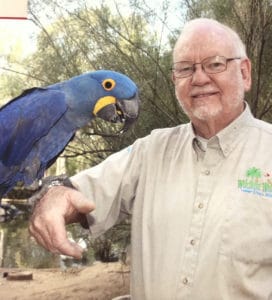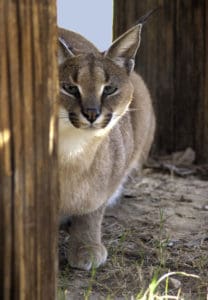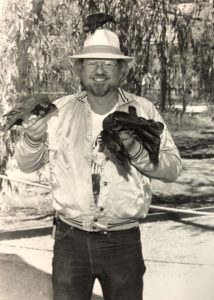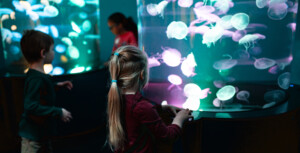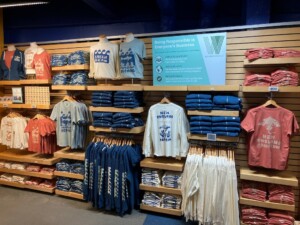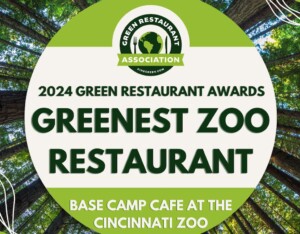Mickey Ollson, director of Wildlife World Zoo, Aquarium & Safari Park, spoke to Blooloop about the attraction‘s expansion, which includes pasture, pond, island and wetland habitats according to the needs of the animals that live there.
Ollson grew up surrounded by animals. He says:
“I was born and raised here in Phoenix on a five-acre farm. I was always interested in wildlife and animals. So were my dad and my grandfather – they loved animals. When I was about six years old, I got my first German Shepherd dog and my first pair of ducks.
“They would ask me, ‘What do you want for your Christmas present or for your birthday?’ And I’d say, ‘Anything alive.’ So as a child growing up, I was fortunate to have a lot of different types of animals in my life, and I carried that on into my adult life.”
Ollson attended Arizona State University, graduating with a degree in marketing and advertising. He worked briefly in that field, then became a teacher. He still kept and raised exotic animals in his spare time.
The beginnings of Wildlife World Zoo
He owned some property he had purchased on the outskirts of Phoenix, and, after several years of teaching, decided to add to it:
“I had made a lot of contacts with zoos and people in the zoo industry, and I decided to buy another piece of property on the west side of the Phoenix metropolitan area”
Around 35 years ago, with a handful of animals and five employees, he opened Wildlife World Zoo.
“It has now grown to be about a hundred acres, with about 600 different species, and an attendance of about 400,000 people a year.”
He makes it sound effortless. Nevertheless, he says:
“For the first 8 to 10 years, financing was a problem; I didn’t have full equity on the property then. But as the Phoenix metropolitan area grew, it grew in our direction. The Phoenix Zoo is almost an hour away from us on the other side of Phoenix.
“We were able to put any profits back into the zoo to add better facilities for our animals, for our keepers, and also, of course, for our visitors. Over the years, I was able to overcome the financial problems of the late eighties and early nineties. By the mid-nineties, we were doing fairly well.”
“I put all the profits back into the zoo, both in expanding the property by buying some of the contiguous neighbourhood property around the zoo, and by adding different exhibits for our visitors as well as improvements throughout the zoo over the years for our visitors, animals, and staff.”
A strong team
Wildlife World Zoo’s education department has three full-time and one part-time educator.
“We started the education department in the early nineties,” says Ollson. “And I’ve been fortunate to have really great leadership over the years in that area.”
“In fact, I have some great leadership throughout the zoo, including two gentlemen that started with me when we opened in 1985. They grew up in the neighbourhood, and they were seniors in high school when we opened the zoo. At that point, they worked part-time as they completed their educations. One is my deputy director and general curator; the other oversees exhibitry here at the zoo.”
The educators put on wildlife education shows on the grounds. There is also a sea lion show in the aquarium, three times a day.
Parrot feeding sessions
“And then we were the first zoo in the world to have a lory parrot feeding session,” he says. This was inspired by a behind-the-scenes visit to San Diego Zoo in the late seventies:
“K.C. Lint, who was curator of birds there [from 1946 to 1976] had hand-raised some lories of various species that year. He took a few agriculturists, including myself, behind the scenes to feed some apple slices to his lories off-exhibit.
“It was such a delightful experience, even from the perspective of an aviculturist, that I remembered it a few years later when I opened Wildlife World Zoo. So we established a lory parrot feeding experience with 25 or 30 lories of several species here in 1986 and were the very first zoo to do.
“We still do our lory parrot feeding the exact same way that it was done back in ’86 because it works so well. Other zoos have followed our example.”
Another of the elements Ollson instigated that has since been emulated elsewhere is the jaguar exhibit:
“In 1987, we built a jaguar exhibit with the pair of jaguars, which are an arboreal species, up above the visitors, where they were perfectly at home. It was a first, also. Now, of course, course, having big cats above visitors is done in a number of zoos here in North America.”
The importance of climate
“When I sit down with my staff to discuss adding different species, we’re very aware of several factors,” says Ollson.
“First of all, the climate is important. Phoenix is warm. Our climate is very much like Australia’s, so we have a lot of the Australian marsupials here. We have huge eucalyptus trees around them, and they do very well here.”
View this post on Instagram
“Wildlife World Zoo does have species that need cooler weather. For instance, we have black-footed penguins from South Africa in our collection and have raised several, but they’re kept completely indoors with an underwater viewing area.
“We have four aquarium buildings here, in a village system, adjacent to the zoo. We have warm-weather penguins there, but they do best indoors, so they’re kept indoors in a large exhibit, and have propagated successfully.”
Choosing the right species
“In addition to climate, we look at our ability and knowledge to manage those species. We look at diet. We also look at whether the species will do well in a desert environment: there are some that do not.
“Large primates, for example, do not do well in our climate because of a fungal disease commonly known as Valley Fever. This is indigenous just to the Southwestern part of the United States, Arizona, Northern Mexico, and a little bit of California.
“Historically, zoos in that area have had trouble with Valley Fever in several different species, particularly in the great apes. So we do not keep species that may be affected by Valley Fever at Wildlife World Zoo.”
Wildlife World Zoo and conservation
In terms of conservation, Wildlife World Zoo spends $50-$60,000 a year in grants to conservation projects. Recipients include The Peninsular Pronghorn Recovery Program, The Marine Mammal Center, Zoological Association of America, Cheetah Conservation Fund, The International Crane Foundation, Gibbon Conservation Center and more.
“We have also been very active with the Sahara Conservation Fund [an international NGO established in 2004 to conserve the wildlife of the Sahara desert and bordering Sahelian grasslands]. It’s one of around 12 groups we donate to,” says Ollson.
“As we are a desert region, we have many species from the desert, especially hoofstock. The scimitar-horned and Arabian oryx are species that do very well here. Historically, we’ve had them in our collection for over 30 years.”
“We helped fund a truck for the use of the Sahara folks a number of years ago. We belong to a consortium of zoos working with the Sonoran pronghorn, an antelope species that comes from Northern Mexico primarily. It is a larger and more colourful animal than the pronghorn found here in the United States.
“Last year, we partnered with Sanderson Ford, here in Phoenix, Arizona’s largest Ford dealership, to donate an F-250 Ford pickup to that group down in Northern Mexico working with the Sonoran pronghorn. We also give monetary donations each year in May to other groups.”
ZAA accreditation
Wildlife World Zoo is accredited by the Zoological Association of America (ZAA).
“We have been ZAA accredited for about 15 years, and have been accredited by the Marine Mammal Alliance for the last six or seven years since we added sea lions in our aquarium.”
To have built the zoo up from a handful of animals into a successful, internationally accredited institution is quite an achievement. However, Ollson is modest about it:
“We have been successful. Part of the success is down to not only hard work and dedication of a great staff, but to being in the right place at the right time to be able to get property around the zoo that was contiguous so that we could expand.
“Then there is the growth of the greater Phoenix area. The city of Phoenix has grown out here and more or less surrounded us. So, we have a half-mile of frontage on an eight-lane highway right by the zoo, which helps.”
The Growth of Wildlife World Zoo
Describing the process by which Wildlife World Zoo has grown over the decades, Ollson says:
“We have a business plan that we decided on when we first opened. My plan was to put all the profits back into the zoo, and to try to establish a reputation among visitors that every year or so they could come back and see something new.”
According to a zip code analysis poll Ollson conducts periodically, around 45% of guests are repeat visitors.
“In order to take advantage of that, and to have new things for our new visitors, our business plan has always been to add some new things each year or two as we could afford to do it. Our plan was also to have 50% of the cost of that project in the bank before we broke ground. In the early days, we would finance 40%-50% of each new project.
“For the last 15 years, we haven’t had to finance anything. The land was paid for, and we have had 100% of the cost in the bank.”
Building on success
“Going back to 1986, we added jaguars and tigers here,” says Ollson. “Then in ’88, we built a new entrance and office building. In ’89, we built a very small aquarium in our old entrance, to see how indoor exhibits would be.
“They were very popular and added to our summer attendance. So the following year we built a building called Tropics of the World, which was a reptile exhibit with about 30 reptile exhibits. And then two years later we built an indoor, small mammal building.”
“And so we continued through the years, building new exhibits. We built a bigger giraffe exhibit. A couple of years later, we added Dragon World, a second reptile exhibit. We built an aquarium that opened 11 years ago, with three buildings. Then we added a fourth, the River Monsters, for large South American freshwater fish.”
Four separate cafes have been added to Wildlife World Zoo over the years:
“When we opened the aquarium 11 years ago, we also added a sit-down dining experience. This is a Kansas City-style barbecue restaurant with a 30-foot shark tank and a full bar. It looks into the white alligator exhibit.”
A patio attached to the bar also features an exhibit with 45 Caribbean flamingos.
Adventure Land
Then there is the 15-acre Adventure Land, showcasing South American species including buffalo, bears, cougars, bobcats, and monkeys. It also features four different rides:
“We have a roller coaster, swing rides and a zip line that actually goes over the animals. We have a track train that goes through our African Savannah area; the ride is about five-eighths of a mile and goes through two animal exhibits: African hoofstock and African birds.”
“Four years ago, we opened a tram ride and our new Safari park. Complete with cheetahs and a white lion from South Africa. Two years ago, we imported three white rhinos. And then earlier this year we opened a five-acre addition to our Safari park. This has pygmy hippos and Grévy’s zebra, onagers and several other species.”
The new expansion at Wildlife World Zoo, which opened to the public on 8 February 2020, features red-billed blue magpies and nilgai antelope.
The relevance of zoos
To Ollson, zoos are more relevant than ever:
“Zoo experiences are the population’s connection to nature. Life is becoming so urbanized. When I grew up back in the 60s, we were out playing in nature, catching, amphibians or a garter snake. As kids, we a connection to nature. But in the last 30 years, that has changed drastically.
“Today, while kids are still active in sports, they’re spending so much time indoors. They don’t all have that experience of having pets and growing up in nature as I did in a rural farming area here in Phoenix. So for the more urbanized societies, zoos act as their connection to nature. Sometimes that trip to the zoo once a year, or every three or four years, is their only connection.
“Here in Phoenix, we no longer have houses on a half-acre or an acre. Now it’s five houses per acre. In many cases they have desert landscaping, so they don’t even have grass in their yard. Many families don’t even have room for a dog or a cat. And so kids are growing up in cities without that exposure to nature.”
Wildlife World Zoo encourages an appreciation of nature
“We have to build an appreciation of wildlife and wild places by having these people come to the zoo; by educating them and giving them that conservation ethic that is so important if we’re going to save endangered species,” concludes Ollson.
“I think we’re doing a better job now than we were 40 or 50 years ago about saving endangered species. That isn’t to say there aren’t many challenges, from poaching to overpopulation to deforestation. There are so many challenges. In many cases, the zoo is the last safe place. The animals are well cared for and they have veterinary care. They’re kept in naturalists exhibits, they have mates to enjoy life with.
“If we are going to continue to have the conservation ethic and a love for nature in the future, zoos are vitally important. A zoo is the major place that urbanized populations learn that love and appreciation for wildlife and wild places.”
Wildlife World Zoo, Aquarium & Safari park is currently closed due to the COVID-19 pandemic and is looking forward to welcoming visitors back once it is safe to do so. Updates can be found on the attraction’s social media channels.

